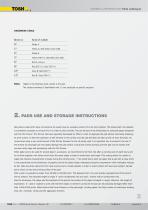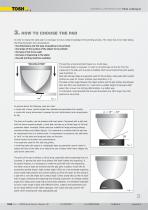
Catalog excerpts

GENERAL INFORMATION Pads catalogue The pad is certainly the most important and critical element in pad printing. It takes the ink from the plate and deposits it on the object to be printed. During this operation it must guarantee that the characteristics and the quality of the graphics to be transferred are kept. In order to work in a perfect manner, the pads must fulfil certain chemical and physical requirements which guarantee their operation in the long term. For the production of its pads TOSH has developed a series of rubbers with characteristics guaranteeing the following: - high mechanical resistance and excellent chemical resistance for longer pad life; - correct surface tension for a perfect ink collection and transfer; - optimal deviation of electrostatic charges for a print without defects; - very smooth and uniform surface finishing for a clearer print. Each single TOSH pad is produced in 3 rubber types with different quality, hardness and resistance characteristics. WHITE RUBBER Basic hardness 14 Shore A. This kind of rubber is recommended when soft pads have to be used. These pads are suitable for printing on large objects which are not very rigid and have highly irregular and convex surfaces. This rubber has the best chemical resistance. The pads made of this type of rubber are particularly suitable for machines with a reduced printing strength. The white rubber is produced in two standard harness always available in stock:: White rubber, Hardness A (corresponding to 0° Shore A) White rubber, Hardness B (corresponding to 2° Shore A) YELLOW RUBBER Basic hardness 23 Shore A. This kind of rubber is recommended when a high degree oft clarity is required, like, for example, in the case of halftone or four-colour process printing. It is useful when a higher quantity of ink is necessary as it is able to take up a higher amount of ink from the plate, compared with other rubbers. It is the rubber that has the better chemical resistance, mostly to catalyst. The yellow rubber is produced in three standard hardness always available in stock: Yellow rubber, Hardness A (corresponding to 1° Shore A) Yellow rubber, Hardness B (corresponding to 5° Shore A) GREY RUBBER Basic hardness 32 Shore A. It is the rubber with the best coefficient of elasticity, lengthening and tearing resistance. Similar to red rubber it is also suggested for the print on objects where the maximum rubber extension is required. It is indispensable for object wrapping up and length of the pad. The grey rubber is produced in four standard hardness always available in stock: Grey rubber, Hardness A (corresponding to 6° Shore A) Grey rubber, Hardness B (corresponding to 10° Shore A) RED RUBBER Basic hardness 35 Shore A. This rubber guarantees the best relation between printing quality and mechanical resistance. It is recommended for printing graphics with particularly thin lines and for particularly precise printing. It is indispensable in order to guarantee very long pad life when this is used on highly irregular surfaces The red rubber offers the largest hardness range without modify its high quality level .It is produced in four standard hardness always available in stock: Red rubber, Hardness A (corresponding to 6° Shore A) Red rubber, Hardness B (corresponding to 12° Shore A) Red rubber, Hardness S80 (corresponding to 3° Shore A) Red rubber, Hardness S100 (corresponding to 1° Shore A) Note: On the basis of specific production requirements TOSH produces rubber with non-standard hardness: TOSH S.r.l. - I - 20089 Quinto Stampi - Rozzano - MI
Open the catalog to page 1
•• • GENERAL INFORMATION Pads catalogue HARDNESS TABLE Shore A Kind of rubber 0° White A Nota: Higher is the hardness level, harder is the pad. The rubbers hardness S identifiable with (*) are produced on specific required New pads or pads which have not worked a lot usually have an excessive amount of oil on their surfaces. This makes them ink repellent. It is therefore necessary to remove this oil in order to print correctly. This can be done in the initial phase by using soft paper dampened with the TAV thinner. This thinner has been especially developed by TOSH in order to...
Open the catalog to page 2
GENERAL INFORMATION Pads catalogue 3. HOW TO CHOOSE THE PAD In order to choose the right pad it is necessary to have a deep knowledge of the printing process. The choice has to be made taking the following factors into consideration: - the dimensions and the type of graphics to be printed; - the shape of the surface of the object to be printed; - the type of ink to be used; - the type of engraving in the plate; - the pad printing machine available. The pad has a typical pointed shape on a round base. The pointed shape is necessary in order to correctly take up the ink from the engraving in...
Open the catalog to page 3All TOSH srl catalogs and technical brochures
-
TOSH ACCESSORIES
11 Pages
-
Serie Compact
2 Pages
-
Serie Logica Platform
28 Pages
-
Serie Logica HighSpeed
24 Pages
-
SERIE LOGICA FLEXIBLE
24 Pages
-
Logica CARTESIO
2 Pages
-
HP series
4 Pages
-
special
11 Pages
-
saddle
5 Pages
-
asymmetrical bar
4 Pages
-
bar
8 Pages
-
square and rectangular base
16 Pages
-
round base (
11 Pages
-
Logica Macro
2 Pages
-
Logica Micro II
2 Pages
-
Logica Mimicro NS
2 Pages
-
Logica 100
2 Pages
-
Logica 07
2 Pages
-
Logica Mimicro N
2 Pages
-
Logica 06
2 Pages
-
Pads
2 Pages
-
LOGICA 03
2 Pages
-
LOGICA 02
2 Pages
-
LOGICA 01
2 Pages
Archived catalogs
-
LOGICA PLATFORM
2 Pages
-
Logica Series Highspeed
2 Pages
-
SERIE LOGICA HIGHSPEED
2 Pages































